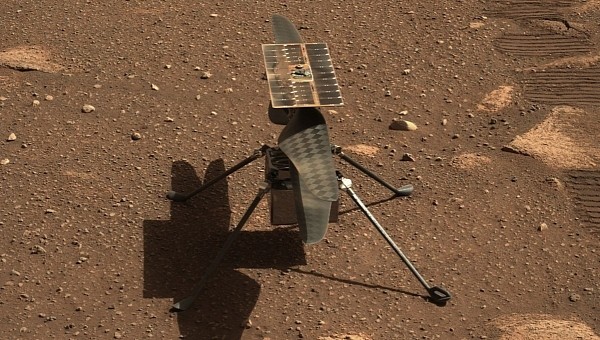One frosty December morning in 1903, the Wright Brothers and the first heavier-than-air manned aircraft on Earth managed to cover a maximum distance of 852 feet (251.5 meters) over four flights. That was before the brothers damned the thing as unflyable and started from scratch. In December 2022, the first aircraft to fly on another heavenly body routinely smashes those figures.
Marking off a year of nothing but excellence from the Ingenuity Martian Helicopter, the historic aircraft completed its record 37th consecutive flight. That's just short of ten times the number of flights the Wright Flyer I managed almost 120 years ago. The pint-sized UAV chopper achieved a maximum height of ten meters (33 ft) and a ground speed of around 6.7 MPH (3 meters per second).
Ingenuity flew for a total of 55.2 seconds on this latest flight, covering a distance of 203 feet (62 m) in the process. This distance alone would have beaten the lengths reached by all but one of the Wright Flyer I's flight attempts at Kittyhawk, North Carolina.
Where Earth's first heavier-than-air, human-rated aircraft relied on archaic wing warping to attempt to maneuver the clumsy thing in the air, the Martian Ingenuity has the benefit of top-of-the-line sensors, cameras, and microprocessors. Further amazing trinkets are found an all-electric powertrain consisting of six perfectly normal Sony VTC-4 solar-rechargeable lithium-ion batteries that you'd buy in bulk off the internet or in retail hobby shops.
These all combine to let Ingenuity, or Ginny, as it's lovingly named, fly with a degree of skill that astonishes even its creators. The razor-thin Martian atmosphere isn't all that forgiving to powered aviation. Unlike the thicker atmospheres of planets like the Earth or Venus, it's fairly difficult to generate lift on the Martian surface. That's why if you think power-to-weight ratios are important here on Earth, it's doubly so on Mars.
With 350 watts of electrical power for Ingenuity's electric motor to work with and a curb weight of 1.8 kilograms (4.0 lb), there are timed food-eating challenges at some restaurants here on Earth that far exceed the mass of this spacecraft. The results are an aircraft that's just as comfortable flying through the Martian atmosphere as the equivalent RC helicopter is here at home.
Though initial NASA estimates stated Ingenuity could continue to scout for the Perseverance rover until at least September 2022, we're currently in late December with no signs of stopping. With over an hour of flight time under its belt, it could be years or even decades before another Martian aircraft even comes close.
It's ironic that this little wonder-copter carries a piece of wing fabric from onboard grafted from the aforementioned Wright Flyer I. Especially because Ingenuity is a considerably more capable aircraft than that historic but terrible flying machine on Earth, Mars, or just about anywhere else with an atmosphere.
Ingenuity flew for a total of 55.2 seconds on this latest flight, covering a distance of 203 feet (62 m) in the process. This distance alone would have beaten the lengths reached by all but one of the Wright Flyer I's flight attempts at Kittyhawk, North Carolina.
Where Earth's first heavier-than-air, human-rated aircraft relied on archaic wing warping to attempt to maneuver the clumsy thing in the air, the Martian Ingenuity has the benefit of top-of-the-line sensors, cameras, and microprocessors. Further amazing trinkets are found an all-electric powertrain consisting of six perfectly normal Sony VTC-4 solar-rechargeable lithium-ion batteries that you'd buy in bulk off the internet or in retail hobby shops.
These all combine to let Ingenuity, or Ginny, as it's lovingly named, fly with a degree of skill that astonishes even its creators. The razor-thin Martian atmosphere isn't all that forgiving to powered aviation. Unlike the thicker atmospheres of planets like the Earth or Venus, it's fairly difficult to generate lift on the Martian surface. That's why if you think power-to-weight ratios are important here on Earth, it's doubly so on Mars.
With 350 watts of electrical power for Ingenuity's electric motor to work with and a curb weight of 1.8 kilograms (4.0 lb), there are timed food-eating challenges at some restaurants here on Earth that far exceed the mass of this spacecraft. The results are an aircraft that's just as comfortable flying through the Martian atmosphere as the equivalent RC helicopter is here at home.
Though initial NASA estimates stated Ingenuity could continue to scout for the Perseverance rover until at least September 2022, we're currently in late December with no signs of stopping. With over an hour of flight time under its belt, it could be years or even decades before another Martian aircraft even comes close.
It's ironic that this little wonder-copter carries a piece of wing fabric from onboard grafted from the aforementioned Wright Flyer I. Especially because Ingenuity is a considerably more capable aircraft than that historic but terrible flying machine on Earth, Mars, or just about anywhere else with an atmosphere.










